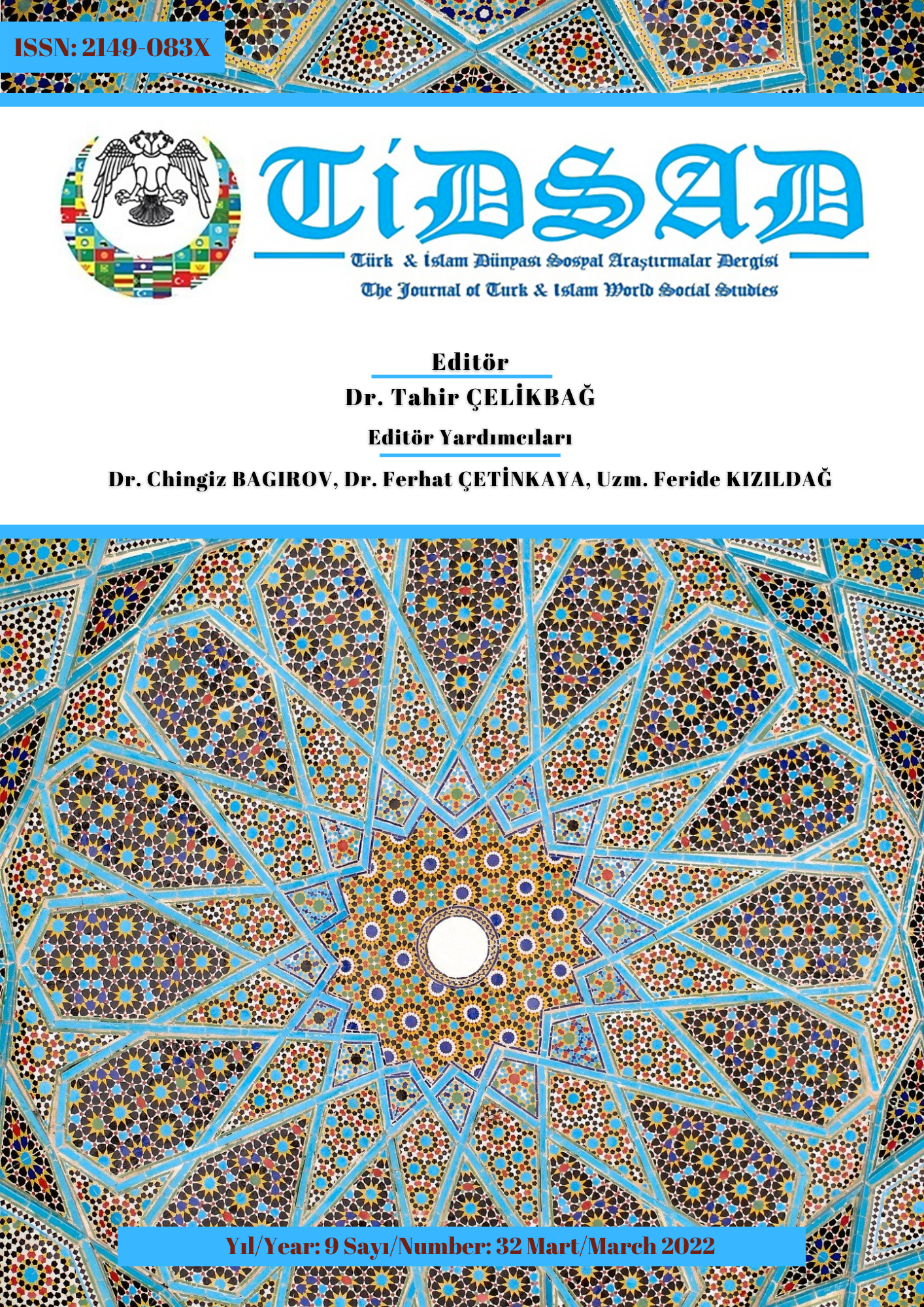Author :
Abstract
Irak’ın en önemli şehirlerinden biri olan Musul, Bağdat’tan sonra en büyük şehirdir. Irak coğrafyası içerisinde bulunan Musul vilayeti yüzyıllar boyunca Türk hâkimiyetinde kalmıştır. Bu araştırmada Musul şehir ile civar ilçe, kasaba ve köylerde H.922-1004/ M.1517-1595 tarihleri arasında kurulmuş ya da öncesinde kurulup ilgili dönemde varlıklarını devam ettirmiş olan vakıflar incelenmiştir. Osmanlı Devleti’nin kuruluş ve yükselme dönemlerinde sosyal hayatın en önemli kurumu olan vakıf müessesidir. Bu çerçevede ilk olarak ibadet kurumları olan cami vakıfları ele alınmıştır. Bu sayede kurulan dini yapıların kurucuları, yerleri, vakıfları ve bugünkü durumları incelenmiştir. Dinî kurumlardan sonra eğitim-öğretim kurumları ile ilgili vakıflar incelenmiş ve bu vakıflar sayesinde kurulmuş olan medreseler açıklanmaya çalışılmıştır. Çalışmanın sonuç kısmında Musul vakıfları ilgili tespit edilen ve açıklanan tüm vakıflar hakkında genel bir değerlendirme yapılmıştır. Osmanlı Devleti’nin yaptırdığı tahrirler sonucunda yazılan defterler günümüzde Başbakanlık Osmanlı Arşivi ve Tapu Kadastro Genel Müdürlüğü Kuyûd-ı Kadime Arşivinde muhafaza edilmektedir. Siyakat yazıyla yazılmış olan defterlerin bazılarının sayfa kenarları yırtık ve kıvrık olmasına rağmen genel olarak günümüze kadar iyi bir şekilde muhafaza edilerek geldiği görülmektedir.
Keywords
Abstract
Mosul, one of the most important cities of Iraq, is the largest city after Baghdad. Mosul province, which is located in the geography of Iraq, has remained under Turkish rule for centuries. In this research, foundations that were established between AH.922-1004 / AD.1517-1595 in the city of Mosul and its surrounding counties, towns and villages or that were established before and continued their existence in the relevant period were examined. It is the foundation institution, which is the most important institution of social life during the establishment and rise of the Ottoman Empire. In this context, firstly, mosque foundations, which are institutions of worship, are discussed. In this way, the founders, places, foundations and current situations of the religious structures established were examined. After religious institutions, foundations related to educational institutions were examined and madrasahs established thanks to these foundations were tried to be explained. In the conclusion part of the study, a general evaluation was made about all the foundations that were identified and explained about the Mosul foundations. The notebooks written as a result of the registrations made by the Ottoman State are kept in the Kuyûd-ı Kadime Archive of the Prime Ministry Ottoman Archive and General Directorate of Land Registry and Cadastre. Although the page edges of some of the notebooks written in Siyakat script are torn and curled.
Keywords
- Maliyeden Müdevver Defterleri (MAD.d) No: 20207;20180.
- Ahmet, İ. H. (1992). Hareketü’l-terbiye ve’t-talim, mevsû’atu’l-musuli’l-hadariyye (C.4). Da- ru’l-Kütüb li’n-Neşir.
- Al-Hamavî (1968). Mu’cemul-buldan (C.4). Kitabevi.
- Akgündüz, A. (1996). Vakıf müessesesi. İstanbul.
- Arnavut, M. (2002). Osmanlı Devleti’nde vakıf. Evkaf Dergisi.
- Bayatlı, N. (1999). XVI. yüzyılda Musul eyaleti. Ankara.
- Berki, A. (1965), Vakfa dair yazıların eserlerle vakfiye ve benzeri vesikalarda geçen ıstılah ve tabirler. Doğuş Matbaası.
- Cercis, A. (1975). Delilu’l-Musul’l-ammı münzü te’sisiha hatta ami. Musul.
- Devellioğlu, F. (2013). Osmanlıca-Türkçe ansıklopedik lûgat. İstanbul.
- Deveci, S. (1963). Cevami’u’l-Musul fi muhtelifi’l-usur. Bağdat.
- El-Azzavi, A. (1949), Tarihü’l-Irak beyne ihtilaleyn (C.4). Kum.
- El-Ömeri, M. E. (1968). Manhalu’l-evliyya ve meşreb el-esfiyya min sadat el-Musul el-hadbaa (C.2). Musul.
- Ertem, A. (2011). Osmanlıdan günümüze vakıflar. Vakıflar Dergisi, 36, 111-150.
- Gündüz, A. (2003). Osmanlı idaresinde Musul (1523-1639). Fırat Üniversitesi Basımevi.
- Hurşit, A. (2012). El-amair el-İslamiye fi imadiyye ve nevahiha hata nihaye kernel-Sani Aşır El-Hicri / el-Samın Aşır El-Miladi. İstanbul.
- İnalcık, H. (2002). Kuruluşundan yıkılışına kadar Osmanlı devleti tarihi (Çev.: Muhammed Arnavut). Beyrut.
- Kazıcı, Z. (1985). İslam ve sosyal açıdan vakıflar. İstanbul.
- -----------. (2003). Osmanlı vakıf medeniyeti. İstanbul.
- Köprülü, F.(1983). İslam ve Türk hukuk tarihi araştırmaları ve vakıf müessesesi. İstanbul.
- El-Kübeysi, M. Ü. A. (1977). Ahkâmül-vakf fiş-şerîatil İslâmiye (C. 1). Bağdat.
- Özdemir, R. (1993). Osmanlı vakıflarının kurulması ve yaşatılmasında devlet kurumlarının işleyişi. Fırat Üniversitesi Tarih Sempozyumu’na sunulmuş tebliğ.
- Öztuna, Y. (1998). Osmanlı Devleti tarihi medeniyet tarihi (C.2). Ankara.
- Pakalın, M. Z. (1983). Osmanlı tarih deyimleri ve terimleri sözlüğü (C.3). İstanbul.
- Şakir, A. (1992). Vilayetü’l-Musul fi’l-karni’s-sadis aşr dirasetün fi evzâuhâ s-siyasiyyeti ve’l- idariyyet ve’l-iktisadiyyeti [Yayımlanmamış doktora tezi]. Musul Üniversitesi Edebiyat Fakültesi.
- Seyufi (1965). Mecme’u’l-Kitabati’l-Muharrati ala Ebniyeti’l-Musul. Bağdat.
- Uluçam (1989). Irak’taki Türk mimari eserleri (B.1). Ankara.
- Yediyıldız, B.(1986). Vakıf. İslam Ansiklopedisi (C.13). İstanbul.





